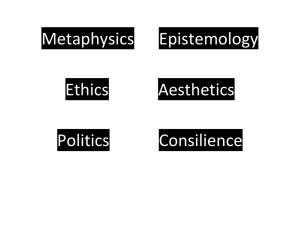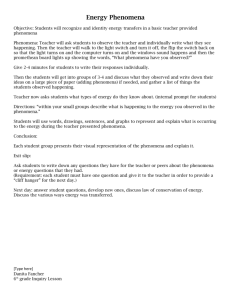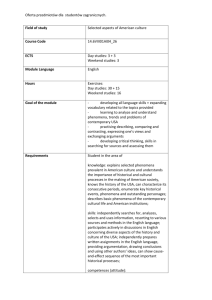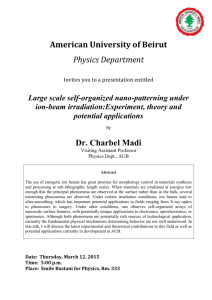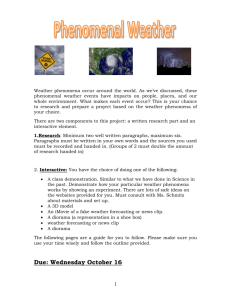Fields of Consilience: An Exploratory Essay with Diagrams
advertisement
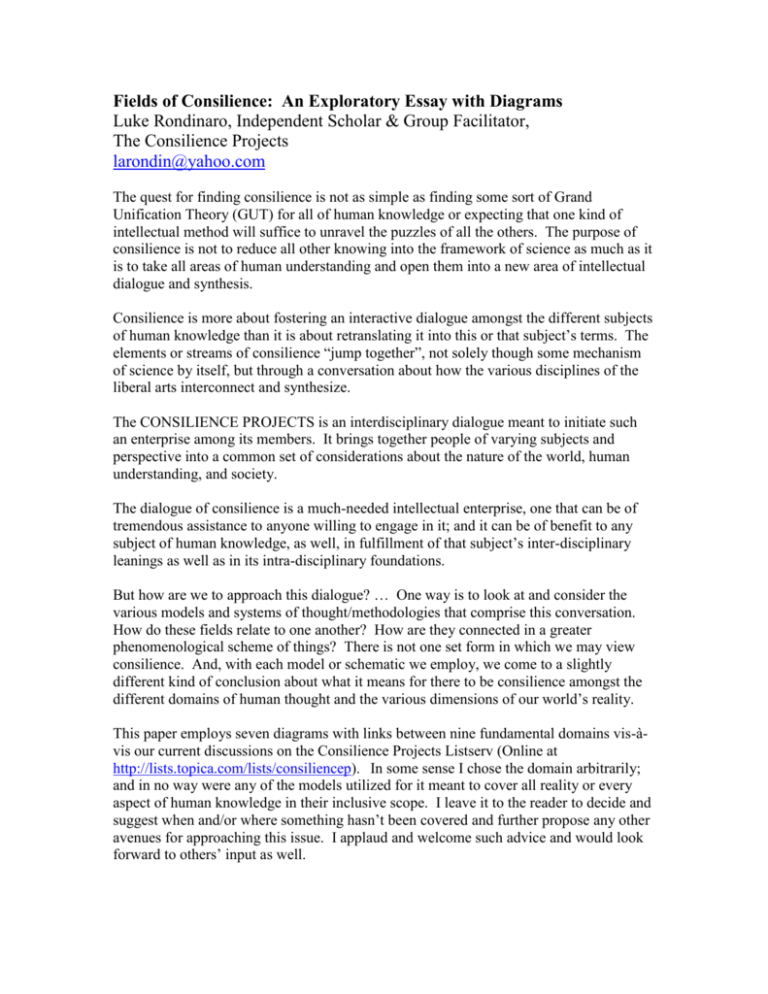
Fields of Consilience: An Exploratory Essay with Diagrams Luke Rondinaro, Independent Scholar & Group Facilitator, The Consilience Projects larondin@yahoo.com The quest for finding consilience is not as simple as finding some sort of Grand Unification Theory (GUT) for all of human knowledge or expecting that one kind of intellectual method will suffice to unravel the puzzles of all the others. The purpose of consilience is not to reduce all other knowing into the framework of science as much as it is to take all areas of human understanding and open them into a new area of intellectual dialogue and synthesis. Consilience is more about fostering an interactive dialogue amongst the different subjects of human knowledge than it is about retranslating it into this or that subject’s terms. The elements or streams of consilience “jump together”, not solely though some mechanism of science by itself, but through a conversation about how the various disciplines of the liberal arts interconnect and synthesize. The CONSILIENCE PROJECTS is an interdisciplinary dialogue meant to initiate such an enterprise among its members. It brings together people of varying subjects and perspective into a common set of considerations about the nature of the world, human understanding, and society. The dialogue of consilience is a much-needed intellectual enterprise, one that can be of tremendous assistance to anyone willing to engage in it; and it can be of benefit to any subject of human knowledge, as well, in fulfillment of that subject’s inter-disciplinary leanings as well as in its intra-disciplinary foundations. But how are we to approach this dialogue? … One way is to look at and consider the various models and systems of thought/methodologies that comprise this conversation. How do these fields relate to one another? How are they connected in a greater phenomenological scheme of things? There is not one set form in which we may view consilience. And, with each model or schematic we employ, we come to a slightly different kind of conclusion about what it means for there to be consilience amongst the different domains of human thought and the various dimensions of our world’s reality. This paper employs seven diagrams with links between nine fundamental domains vis-àvis our current discussions on the Consilience Projects Listserv (Online at http://lists.topica.com/lists/consiliencep). In some sense I chose the domain arbitrarily; and in no way were any of the models utilized for it meant to cover all reality or every aspect of human knowledge in their inclusive scope. I leave it to the reader to decide and suggest when and/or where something hasn’t been covered and further propose any other avenues for approaching this issue. I applaud and welcome such advice and would look forward to others’ input as well. The domains I chose to deal with in my models/visuals for this paper are: our physical world (as a substrate from which all other domains of human knowledge and natural phenomena are based), the physical scientific domain (which I’m expanding in this sense to include the full spread of all the natural sciences including the biological), the domain of psychological study (which includes Psychohistory), and a separate domain as well for social affairs and day-to-day human “experience” as people directly and concretely relate with their world. Also included are distinct domains given for Paul Ziolo’s “Generalized Psychohistorical Matrix” model, John Landon’s Eonic Effect, the study of Holodynamics, World History, and World Systems Analysis. Now why include separate sections for domains I have? The reason is that they constitute distinctive, specialized both in reality itself and the consilient system. Eonics, the Generalized Psychohistorical Matrix, and Holodynamics, for one, are core frameworks of the system. These domains aren’t just ‘part of something else.’ Each can rightly constitute its own domain regardless of the larger intellectual fields to which they are connected (i.e., World Historical Studies/Evolution in the case of the Eonic Effect; or in the case of the Generalized Psychohistorical Matrix, the field of Psychohistory itself). In addition, because the Psychohistorical Matrix straddles this interzone between macroscale phenomena and smaller micro-scale phenomena, with outriders in psychological study, social affairs, physical science, and the world’s physical substrate, and in such things as Holodynamics, World History, World Systems, and the Eonic Effect, it ends up occupying the mid-section or core region of our consilience model pictorials [as in Diagram I]. More particularly, the following can be said about each of these three areas: (1) The Eonic Effect occupies its own domain because of its connections to human experience as well as the ontology of history. It acts as the regulatory clock to the rest of evolving world over time. As such, it is like a clock of a computer regulating the functions of the system in which it is framed. Or, again, it can be seen to be like the beat of the drummer, aligning the movements of a marching band in a parade. Particularly, it would act as the driver, engine, or master program of the system, guiding all subsystems and processes in the larger system, not only to their own distinct ends but to their synergistic, directional end in the unitive system itself. (2) The Generalized Psychohistorical Matrix occupies its own domain as well. It too encompasses, as it were in the world, its own unique set of processes and phenomena that connect into all other parts wholistic system. It has outriders to the Eonic Effect through its roots in Psychohistory and Catastrophe theory, connectors to World Systems and World History as studies and systems in the real world through the social and macro-historical implications of PH; and yet is grounded to the scientific domain, social science, and the substrate of our physical world, because of its basis in our world’s materiality. (3) Finally Holodynamics is also provided its own domain. For, as with the other two fields, it has roots in both empirical science as well as modes of knowledge that reach beyond science in our world’s reality. Hence, it constitutes not just another field of understanding about real world phenomena but an actual framework in which that reality operates. However there’s a difference with respect to holodynamics that Diagram I should also make very clear. Whereas the other domains have their own distinct structures, holodynamics operates as their relational matrix. They act as the “units” of the system; holodynamics acts as interactive, integrative dynamic. Therefore, just as Eonics and the generalized psychohistorical matrix have a special place in our systems model, so too does holodynamics. As to the other domains included per Diagram I: World History, World Systems, psychological study/psychohistory, and our world’s physicality or physical basis (i.e., the substratum of our physical world) have been accorded separate categories as well. Why? They’re as conceptually arbitrary and conventional as any other intellectual subjects for certain. However, since they also comprise key aspects of our world’s phenomenological basis as well, this warrants their inclusion in our consilient system and pictorials (and even their centrality in that schema vis-à-vis other categories of natural/human phenomena and classifications of human knowledge. Human “experience” (through social “consciousness” and social issues) is granted its own distinct domain since it is not completely under the dictates and characteristic processes of social science. Intellectually, social awareness and affairs comprises its own field. It is equally – if not more (in some cases) - applicable to the experiential, aesthetic domain of the humanities as it to processes and phenomena of human activity as studied under social science disciplines. Therefore, the fact that it is so requires us, not only to give this principle its own domain, but to also grant it its own conceptual classification as well. I refer to this phenomenon as being “socscience” which collectively stands for the distinctive human qualitative dynamics of “social consciousness”, “social awareness”, human “experience”, “human” affairs, and “social issues.” In short, “socscience” is the ‘science’/’scientia’ or unique systematized “knowledge” of human activity in its experiential dimensions … “Socscient” phenomena too is granted its own domain in our consilient system. Regarding the rest of the diagrams included with this paper, a few other remarks are in order as well. Starting with Diagram II, we note an obvious difference between the first and the second pictorial. Where lines and rectangles constitute the basis of the first diagram’s domains and connections, Diagram Two consists of the same fields but under the lens of a different geometric. Circles are used instead of lines and boxes, and whereas (I) is centered on distinct forms for each of the domains with the grid of connecting threads tying them together in roughly linear fashion, (II) is about how these domains emerge from the point of their singularities expanding outward into one another’s domains, creating thus the dynamic of cross-hatching interconnections. In other words, the basis of Diagram Two is nonlinear. What arises in this non-linearity? There are actually two plausible answers here: (1) the domain of non-linear dynamics (a.k.a. chaos theory or complexity) … or (2) on the level of ontology and NATURALISM - where we deal with the triple considerations of metaphysics, the physical, and their inter-zone of in-between phenomena - the second dynamic we could say is emerging is that of “holographics” and/or “holodynamic” phenomena. How can this be? It’s because, whatsoever level we choose to consider these fields that we are analyzing in, that level ends up characterizing both the emergence/emanation of their systematic functions and their intersections with one another. In other words, on a standard material-physical-natural plane, this emergence is indicative of complexity dynamics – either as quantum chaos or deterministic chaos or complexity. However, on a transphysical-naturalistic plane dealing both with human processes and higher, deeper operations of our cosmos’s reality, the emerging integrative-interactive region of that world … (our ripple-effect as in a pond where each of the separate stone drops creates a basic ripple that grows as a wave into its own domain and then converges into the others, eventually creating a chaotic dissonance, neutralizing each field into a new systemic whole and/or as might be described creating a new circle – the pond structure- dynamic itself as an integrality) … is indicative of universal holographic and holodynamic phenomena. That is to say, the higher dynamic of the transphysical world itself (which constitutes an elevated dimensionality to existing systems in our world) ends up being embedded into the lesser, more concrete dimensions of the physical, biological, and human worlds of nature and history. Now “transphysics” is meant to denote that area which straddles both metaphysics and our physical-natural world. Naturalism and teleology, I would argue, are subsets of the transphysical domain, and in similar fashion so are considerations of classical ontology, epistemology as well as discussions of historical theory as well in the thought systems of Kant and Hegel. All are trans-physical, which is to indicate - while they aren’t distinctly physical-material phenomena or completely metaphysical (referring to the highest dimensions of our world, the state or quality of consciousness itself, and the universals/ great ideas explored in literature and philosophy)(i.e., truth, beauty, love, justice, and so forth) either – they are of their of unique sort in that greater system … thereby deserving a classification of their own. And, that’s why they’ve been given the designation they have. They aren’t quite metaphysical and at the same time they aren’t quite physical either; they are of their own distinct category in nature (to which I’ve ascribed the term I have: that being “transphysics” or “transphysical”). The Eonic Effect, I would argue is one such example of a natural process operating out of the transphysical realm of our world. Holodynamics (and higher order holographics) is also, to a degree (with two notable caveats: HD is also a property of the physical-biological and metaphysical domains). Holodynamics and the Generalized Psychohistorical Matrix have a common source in the microbiology of human neural functioning. For, within the microtubules of neurocellular frameworks are contained both the basic units of holodynamic phenomena (the “holodynes”) and the ultimate roots of psychohistorical processes in human experience. Holodynes constitute the images on which sense data through the cells are recorded as a camera might record a picture; yet they also comprise the seat of human consciousness and construction of human information systems as well – out of which all units and functions of human communications and diffusion of information proceed (as would memes, group fantasies in psychohistorical phenomena, etc.). All would eventually arise out of what occurs in the microtubules and in terms of the holodyn(amic) order, building up through human events towards the higher planes of transphysics and metaphysics in our universe. But where Psychohistory and the Generalized Psychohistorical Matrix distinctively build upon their common base with holodynamics is in consideration of two other phenomena within the human communicational/experiential system, i.e., in terms of traumatization and the impact of improved childrearing on development. Psychohistory, by definition, sees these factors as constituting a major if not central influence on human activity; and, so, up towards the higher dimensions of universal history and natural processes in the world, we can trace the effect of how childrearing and generic/subsequent trauma have further molded our view of reality even in its highest planes (by virtue of the GPHM). Now, holodynamics, too, is born out of such traumatization; but where the difference seems to stand between the two subjects regards consciousness. PH focuses on the formation and alleviation of such trauma on levels below human consciousness and specifically through what can be brought forth through improvements in childrearing; Holodynamics on the other hand appears to view these underlying patterns as being able to be transformed through conscious direction. Regardless, though, the effect of such patternization of trauma is the same: it builds through our physical and human settings [on up towards our world’s higher dimensions]. In other words what we’re seeing (through the paradigm of psychohistory as a field), in the emergence of human civilization and the unfolding of reality’s ever-ascending levels, is the “fractal expansion of the fetal unconscious” (Paul Ziolo, Trauma and Transcendence, Section 5)(See references at end of this paper). And, what resides there in such metaphysical and transphysical dimensions? … Perhaps, the large-scale mirror of the cosmos itself. We see a reflection of ourselves in that universe, while in turn we reflect the eerie complexity of that universe within us: scientifically, humanly, and metaphysically. “Consciousness” and “physics?” … Indeed! That’s what’s involved in our enterprise when we get down to the elementary basics and overarching principles of consilient reality and knowledge. True, open-ended, convergence is at the heart of this endeavor. For in the words of Flannery O’Connor’s story, “Everything That Rises Must Converge.” All these distinct streams of phenomena in our world, humanly and naturally, arise, emerge, and converge into a new synthesis of consilience and understanding. So how do we arrive at such a point in our study and research? … Through open-ended study and dialogue. … Though interdisciplinary research and inquiry … and through contrasting subjects, paradigms, and perspectives all flowing into the common pool that is called consilience. The dialogue awaits. Diagram I – Fields of Consilience – A one-dimensional, linear diagram. Basis in “lines” and “boxes.” An introductory model, rooted in a more classical understanding of human knowledge and phenomena. And, yet we also get of glimpse of higher dimensionality in this diagram through its representation of and connections to our world’s physical foundation and holodynamics. Diagram II - Fields of Consilience – Holodynamic Emergence between Fields An alternative representation of the domains of Diagram I, this time as emerging and intersecting wave patterns arising from the source principles of our seven major subject fields in question. This time Holodynamics arises from the cross-hatching and synthesis of the domains growing into one another. However, on the materialphysical plane, it can equally be argued that Chaos/Complexity is what is emerging into the larger framework as represented by the bigger circle. Diagram III - Fields of Consilience – Intersecting Regions in the Consilient System How do these domains/fields of consilience intersect? The diagram below offers us a view of it for us to consider. However, the pictorial is also somewhat deceptive. A more accurate diagram would not only show us what we have here, but also show just how much the big three subject groupings (social science, humanities, and science) actually inter-penetrate each other. Additionally, the intersection of “socscience” would also align more squarely with physical science and holodynamics as well. Diagram IV - Fields of Consilience – Structural Frameworks in the Consilient System This diagram presents the structural framework of the model. Cylindrical units atop the main stage are simple and straightforward. Built on top of the structures for social science, the humanities, and physical science, are further units for world history, social affairs, world systems, etc. But there are also paradoxes and discontinuities to the system as well. At the height of this framework in the area designated for transphysical phenomena, an optical illusion represents the interconnected, paradox existing between the Eonic Effect and HolographicsHolodynamics. Evolutionally-speaking, Eonics as “big history” is the more overarching phenomenon – regulating and shaping all other phenomena below it (including HD). However, an equal case can be made for the Eonic Effect being an example of a process falling under the auspices of holodynamics. Therefore, they exist in paradox to each other. Also, a further discontinuity exists between the transphysical and physical realms in relationship to each other. Which gives rise to which? … It can really be argued that “both” do in different respects. The transphysical clearly can be seen to form and shape the physical; but on the other hand, the physical too gives rise to and shapes transphysical phenomena as well. Diagram V - Fields of Consilience – Intersectional Projections in the Consilient System This diagram further explores the paradoxes amongst the different domains of the model. Now, obviously we can trace social affairs and human “experience” from the transphysical realm as a projection from the holographic- holodynamic order, etc. But we can also see that order itself (and the entirety of the metaphysicaltransphysical dimensions in our world) as themselves being a projection of the human psychological order upon nature itself. Diagram VI - Fields of Consilience – The GPHM in the Consilient System (Part One) We begin here with the inter-fitted cone drawings in the box, zooming-into what we see in the rest of the diagram. I see the generalized psychohistorical matrix as a centerpiece for consilience in general and our model in particular. Why? … Because its range of influence and interconnection grows into all other domains of the consilient system, be they physically-based, humanistically-based, or transphysical/metaphysical. The GPHM due to its wide range of linkages with other subjects would be core to any consideration of consilience. Now, obviously for the purposes of this flowchart, I have included more to the discussion of the psychohistorical matrix than just its base in birth trauma and neoteny. The reason for this has been to better illustrate connections to our other domains in the consilient model – i.e., to holodynamics, world history, world systems, et al. All these, at some point, ultimately relate back to the matrix of psychohistory. In addition, it all builds on the base of the physical world and the “emergence” of life and consciousness/complex psychology from that point. (All terms are here drawn from Paul Ziolo’s essay Trauma and Transcendence, although the particular way I presented them are my own based on his discussion there)(For a key to abbreviations used in the flowchart, please see “Abbreviations used for Diagrams VI and VII” and at the end of this paper). Diagram VII - Fields of Consilience – The GPHM in the Consilient System (Part Two) Abbreviations Used for Diagrams VI and VII: QBD (Quantum Brain Dynamics) Orch OR (Orchestrated Objective Reduction model), MT (Microtubulin model) MLBDF (Multi-Level Bidirectional Feedback) ECHC (Expanding Cone of Human Consciousness) CGT (Core of Generic Trauma) (All further notations of Diagram VII are based in the overall relationships and principles of the psychohistorical matrix as denoted in the text of Section Five in T&T, and should be self explanatory after analyzing that section) For Further Reference, Please See: On the Eonic Effect and Big History, http://eonix.8m.com and http://www.fss.uu.nl/wetfil/96-97/big.htm On Psychohistory and the Psychohistorical Matrix, http://www.psychohistory.com and http://wsarch.ucr.edu/archive/papers/ziolo/PISTA03-paper/doc On Holodynamics, http://www.holodynamics.com On Consilience, Wilson, Edward O. Consilience. Knopf; 1st ed., 1998. http://www.2think.org/hii/wilson.shtml http://www.mindspring.com/~kimall/Reviews/consilience.html On The Consilience Projects, http://www.geocities.com/larondin/consilience_projects.html http://lists.topica.com/lists/consiliencep
